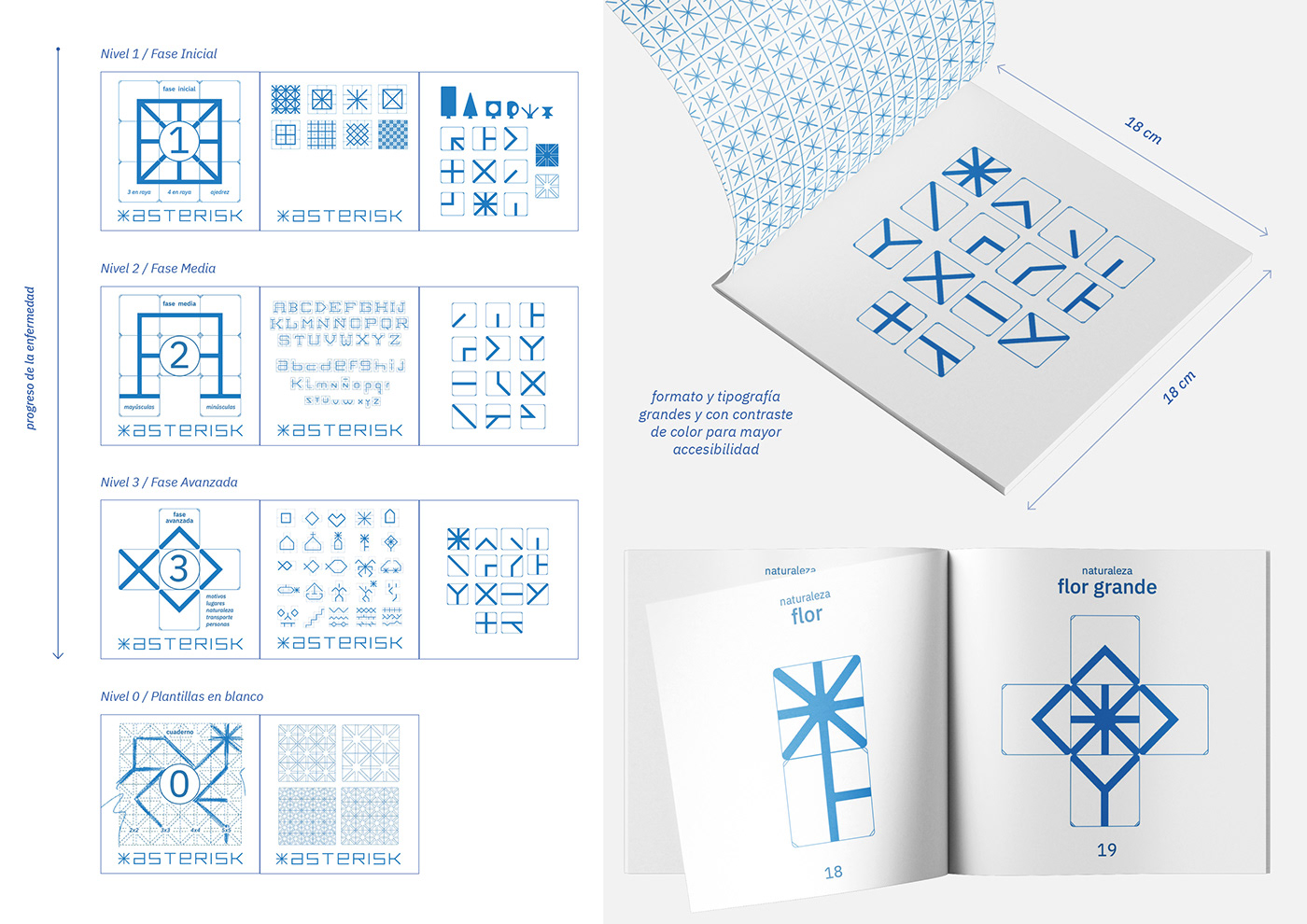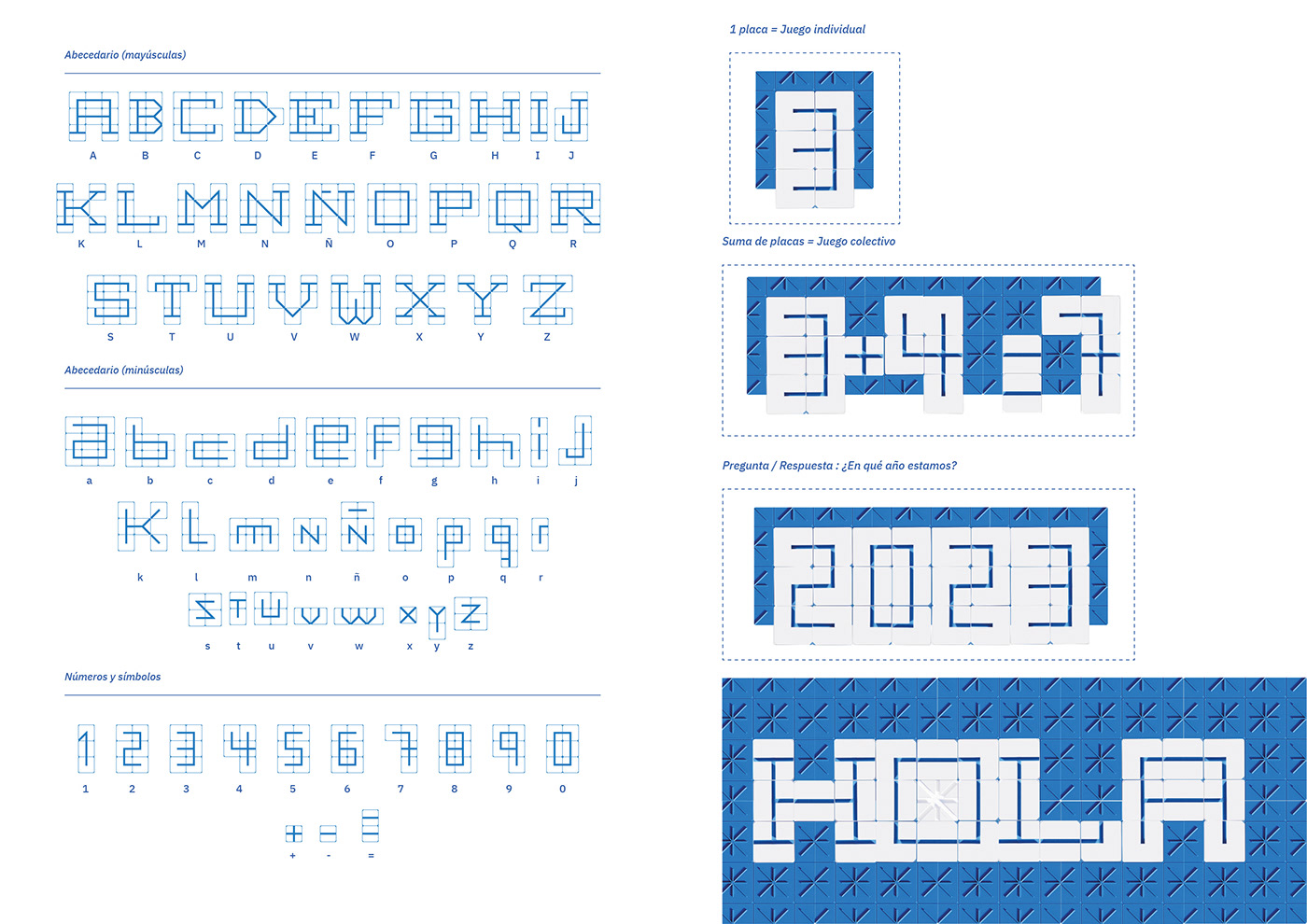
Asterisk: Exploration and therapeutic design of play in dementia care facilities.
Final Degree Project 2023
Student: Belén García López
Tutor: Andrés Tabera Roldán
School of Architecture University of Navarra
Tutor: Andrés Tabera Roldán
School of Architecture University of Navarra
In 2050, according to HelpAge's Global Aging Index, Spain will be one of the world's most aged countries1 . It is estimated that 40% of the population will be over 60 years of age. As a result of this "aging society", new challenges arise in many fields. Of course, design, due to its value as a service to society, has recently focused attention on a type of design that is inclusive and focused on the third age, which aims to facilitate access to products and services that respond to the needs and physical and cognitive limitations of this group.
The toy industry has always been very focused on the infant stage, but if we take into account that the population pyramid is inverting6 and that there are fewer and fewer children and more and more older people, why don't we start to see the latter as an opportunity to develop new products adapted to their needs?
This final degree thesis aims to take part in the revindication of the character and potential of playfulness, of play as an attitude, and thus to explore the potential of play and, specifically, of toys in order to develop a more directed and focused treatment for people with disabilities in both care and domestic environments.







The design research presented follows a process structured in four phases: (1) analysis and reference research, (2) ideation, (3) prototyping and (4) validation. The project focuses on the development of toys focused on the treatment of dementia in the elderly. The objectives are to develop an appropriate visual and formal language, establish a set of principles for the design process, prototype and test the designs with occupational therapists and people with dementia, and make the production and distribution of the toys accessible to both nursing homes and family members.
The final product, Asterisk, is a game set designed to offer an adaptive treatment to the needs of people with dementia, working cognitive stimulation and fine psychomotor skills through the strategy and movement of the pieces on a board composed of configurable modules.


Asterisk is a play set designed to offer a more focused treatment for people with dementia. Its name and design are inspired by the idea of correcting, differentiating or creating an exception to existing products on the market, while at the same time taking a stand on the cliché that games are only useful in childhood. The key to the project is not to invent a new game, but to reuse, rebuild or reconvert the existing mechanisms of several traditional board games and adapt them to the real and changing needs of users with dementia.
The game consists of a board composed of modules that can be configured in different shapes and patterns. Each module has a geometric circuit in which a token related to a praxia is hooked, which is used to play different games and exercises. These games and exercises are classified by levels that correspond to the progress of the dementia disease.
The objective is to work cognitive stimulation and fine psychomotor skills through strategy and movement of the tokens.










Asterisk is designed to adapt to the process and the limits set by the disease, so it can be used both in the early stages of dementia, as well as in advanced stages. The construction of the board is a game in itself and the reference templates with instructions on how to form the boards and guidelines on how to introduce or guide each type of user are divided into different levels, from level 0 to level 4.

Level 1: Initial Phase
In a pre-diagnostic, early or mild phase, complex strategy games such as chess, tic-tac-toe or four-in-a-row are proposed.
In a pre-diagnostic, early or mild phase, complex strategy games such as chess, tic-tac-toe or four-in-a-row are proposed.

Level 2: Middle Phase
In an intermediate phase, games such as dominoes or matching pairs are recommended and the templates are letters with which to form words or numbers with which simple mathematical operations such as addition or subtraction can be performed.
In an intermediate phase, games such as dominoes or matching pairs are recommended and the templates are letters with which to form words or numbers with which simple mathematical operations such as addition or subtraction can be performed.

Level 3: Advanced Phase
In a moderate phase, basic geometric motifs such as fish, flowers or borders are proposed.
In a moderate phase, basic geometric motifs such as fish, flowers or borders are proposed.


The system can grow and acquire more modules, in this sense, the product can be used in two types of scales. A larger one, for a residential context and a smaller version, for a home environment. In day centers or residences, occupational therapists would make a professional use, while in private homes, the availability of these games facilitates the participation of the family in a shared recreational activity in which communication and the enjoyment of the game itself also provides benefits at the cerebral level.
Residential environment
In a residence and specifically in a day center, the system allows creating game configurations adapted to the needs of each user, perhaps for Pepe it will be more interesting to play tic-tac-toe or dominoes with his friend Paco, but maybe Juana finds it difficult to play tic-tac-toe and likes to combine pairs of tiles or design borders and geometric motifs much more.
In a residence and specifically in a day center, the system allows creating game configurations adapted to the needs of each user, perhaps for Pepe it will be more interesting to play tic-tac-toe or dominoes with his friend Paco, but maybe Juana finds it difficult to play tic-tac-toe and likes to combine pairs of tiles or design borders and geometric motifs much more.

Home Environment
When Pepe, Paco and Juana return home in the evening, the occupational therapists recommend continuing these exercises or methodologies at home, so the product can be used on a smaller scale at home with their grandchildren or family members. The latter can also use it at any level of play, thus demonstrating that it is an intergenerational product.
When Pepe, Paco and Juana return home in the evening, the occupational therapists recommend continuing these exercises or methodologies at home, so the product can be used on a smaller scale at home with their grandchildren or family members. The latter can also use it at any level of play, thus demonstrating that it is an intergenerational product.




Platform and distribution
Asterisk is an open source project, made available to the community through an online platform where all the .stl files of the set (modules, boards and cards) as well as a repository with templates and instructions for use and new ones developed by users, thus encouraging collaboration, experimentation, continuous learning and the free flow of ideas and knowledge.
Asterisk is an open source project, made available to the community through an online platform where all the .stl files of the set (modules, boards and cards) as well as a repository with templates and instructions for use and new ones developed by users, thus encouraging collaboration, experimentation, continuous learning and the free flow of ideas and knowledge.
This approach allows the customization of each set, self-producing only the modules needed for each user and being able to increase the scalability of the set according to the usage habits of each context.
The production and distribution of the set will be of two types:
Self-made: the .stl files are downloaded and printed at home.
3rd made: In case of not having the means to print at home, they can be ordered online through the platform.



This project has been validated in three sessions, the first two focused on research (24.03.23) and ideation (04.04.23) and the third on prototyping (12.04.23) to understand the real needs of the project context.
The validation has been carried out in a residential environment due to the variety of users and therefore the variety of needs that a product used in residences should have to cover.
To this end, we have worked hand in hand with a nursing home in Pamplona, specifically the day center of the Solera Asistencial group located in Pio XII, with direct access to workers, occupational therapists and the residents themselves.
Below is the validation process of the third session, in which a group of users with different profiles of the previously explained stages of dementia were selected. During the validation, the interaction of users with the first prototypes of the physical game was carefully observed, paying special attention to their ability to form the boards and also how they manipulated the tiles, if the size was correct compared to their fingers, if they slid well through the circuits....
On the other hand, we observed the cognitive interaction of the different profiles (early and advanced dementia), their ability to form different templates with the modules of the board, from tic-tac-toe to letters and small mazes.





